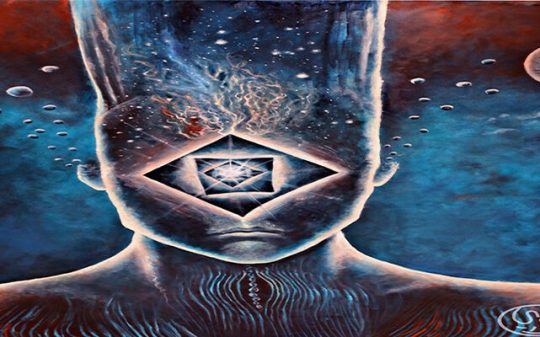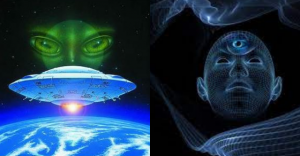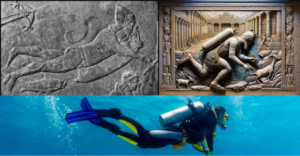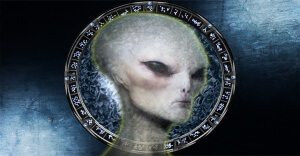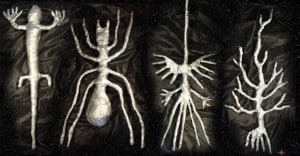Few cultures were as preoccupied with the afterlife as the ancient Egyptians. Their society relied heavily on a mythos of rebirth and transformation through the attainment of higher levels of consciousness. This is especially true of the fortunate few that made up the ruling class, as evidenced standing the symbolism-heavy narrative they left behind etched in stone.
One of their most important symbols – the Eye of Horus- bears testimony to their search for the secrets of this life and, as it turns out, this ancient symbol might be a key to unlocking the perspective of a continued existence on higher planes of existence.
The Sky God Horus was the one of the ancient Egyptians’ most significant deities. The Eye of Horus, also known as Wedjat (sometimes Wadjet) was a symbol of protection and the royal power that the gods bestowed upon mankind. When used properly, it acted as a ward against evil and offered protection in the afterlife. Should it come as a surprise when we realize that this symbol of immense power is actually very similar to the structure in the brain at the center of which the pineal gland is found?
The pineal gland is found in the center of the human brain, between the two hemispheres. It resembles a pine cone (hence the name) and can be found in nearly all vertebrates. Biology tells us that its role in the human body is to secrete melatonin, a hormone that modulates sleep patterns. Some evolutionary biologists believe that the vertebrate pineal cells possess a common evolutionary ancestor with retinal cells. Structurally speaking, the pineal gland acts like it was once an eye.
The Egyptians weren’t the only ones to hold the pineal gland and its representations in such a high regard. This symbol can be found from the ruins of Babylon to the Christian scriptures and everywhere in between. The ancient Greeks considered it the seat of the soul, a notion that was later picked up by the Romans. In Hinduism, it plays an even greater role and is associated with the Ajna chakra, the part of the brain that signifies the conscience.
Throughout history, various cultures have identified the pineal gland as the Third Eye, the All-Seeing organ Plato so ceremoniously described in Republic:
“In every man there is an Eye of the soul which is far more precious than ten thousand bodily eyes, for by it alone is truth seen. The Eye of the soul is alone naturally adapted to be resuscitated and excited by the mathematical disciplines.”
Mathematical disciplines. Hmmm. Was Plato talking about Sacred Geometry, by any chance? Because the ancient Egyptians made heavy use of this concept, and it permeated many aspects of their culture. The Eye of Horus itself stands testament to this idea.
The ancient Egyptians’ architecture is further evidence of their special relationship with numerology. Many Egyptologists have dedicated their energy to uncovering the sacred knowledge the builders of the pyramids possessed.
One of them was French occultist René Adolphe Schwaller de Lubicz, and in his book The Temple in Man, he describes the multiple instances of hidden symbolism present at the Temple of Luxor in Egypt. In 1935, Schwaller de Lubicz moved to Egypt with his wife and daughter and began the arduous process of mapping and measuring the entire temple. He would spend the next 15 years of his life trying and succeeding in finding clues regarding divine mathematics.
Built nerly 3,500 years ago, the Luxor Temple is a perfect example of the use of sacred geometry in architecture, as it reflects the exact proportions of the human body. Even more important, this masterpiece of symbolist teachings reveals the occult anatomy of man. Schwaller discovered that inside the Temple of Luxor, representations of the Eye of Horus abound in the southern secret sanctuaries. This means that the ancient Egyptians viewed the pineal gland as a doorway or a passage. It represented the symbolic entrance to man’s head, the seat of his intellect and his soul.
The ancient Egyptians relied heavily on symbolism and our knowledge of their culture was extracted from their figurative representations. But this process of deduction is far from being perfect and you can be sure that some of the intricacies of their beliefs were lost in translation.
Despite all this, one thing is abundantly obvious: they held the pineal gland in high regard and they knew it held the key to exploring the spiritual world. By subjecting it to the principles of sacred geometry, they acknowledged the Third Eye as a corridor to the outer cosmos that originated man.
There are reasons to suspect the Egyptian culture might be much older than modern science is willing to accept, pushing back the use of this divine symbol by millennia and giving birth to a legitimate question: did the Egyptians discover the role of the pineal gland on their own or did they receive this esoteric knowledge from a much older and wiser culture? The fact that symbolic representations of the All-Seeing Eye can be found throughout the globe in cultures spanning thousands of years seems to support the latter.
So what does this mean for us? Should we rely on what human anatomy tells us and further demystify the capabilities of this spiritual organ? Do we let it become calcified without attempting to investigate its life-changing powers that seem to transcend time and space? Do we rub sand in our own eyes? Or do we explore?
Stay tuned for future articles and content on how to open the 3rd eye. Subscribe by clicking here for updates.
Use Hape (or snuff) Sacred Tobacco Plant Medicine: Hape or snuff is a plant medicine that is useful in decalcifying the pineal gland and opening the gland up for action. It allows the body and pineal gland to open. This is a powder mix of tobacco (just so you know) along with other herbs that you quite literally blow up your nose. It’s a bit of an experience and a bit of a rush as you can imagine. I love it. It works great and makes you feel really grounded and each blend has different affects. I have seen positive results with the Nukini, Eucalyptus and Bullet Hape from Four Visions Market. You can visit them here: https://fourvisionsmarket.com/hape-apothecary/tribe/healthywildfree/ Make sure to use the discount code healthywildfree for 10% off your order!
